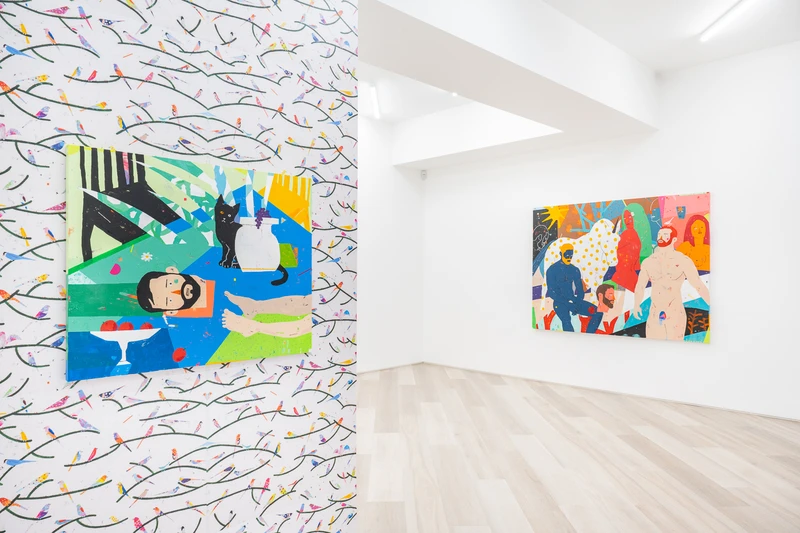Hyangmok Baik: While you were sleeping
1 Apr-6 May 2023
PV 1 Apr 2023, 1-4pm


Exhibition text by artist Andrew Salgado
(The Gasoline Pump’s Not A Toy)
In writing this brief for Hyangmok Baik’s exhibition, I came across a quote by Gunter Grass, one of Germany’s most regarded writers, and author of the classic novel The Tin Drum, which is, among other things, about a boy who wishes to stop growing:
People change with time. There are things that happened to a person in his childhood and years later they seem to him alien and strange. I am trying to decipher that child. Sometimes he is a stranger to me. When you think about when you were [young], don’t you feel a certain alienation?
The quote struck me for a few reasons, most notably for its rather serendipitous connection to the thematic foundation in Baik’s forthcoming solo exhibition, While You Were Sleeping, his second solo at BEERS London, and third such outing with the gallery, most recently in a two-person exhibition with Adébayo Bolaji at London’s Saatchi Gallery, entitled Bitter Nostalgia.
My materials were threadbare. I was presented with a lead image, (“Third Wheel”) and paragraph, no more, detailing Baik’s musings about this, his most recent body of work. “Expressing this story in English is most difficult for me,” he states. I know this feeling; most artists do: whether writing in English or in Baik’s case, his native Korean, most artists struggle to speak or write about their own work. Why? It’s superfluous, to a degree: to adorn what is already such an immediately visible artform with more words is fluff, as annoying as a footnote, the accouterment to what is already presented as intended. (There’s some meme of a guy wearing, like, ten pairs of sunglasses. Or maybe some lame comic I’ve imagined with an aghast waiter hovering over posh nosh and caviar: ‘you want salt with that?!)
So you see, I cannot help but create stories behind and as a method to talk about Baik’s work. In fact, I feel invited to do so. His previous collection included a gender-and-race-swapped Leda and the Swan, boys with coloured phalluses riding atop unicorns, polka-dot skies, and dozens upon dozens of imaginary birds. At times it all feels a bit trippy, a bit macabre: the psychedelic tunnel wherein Gene Wilder’s Willy Wonka scarred generations of children or C.S. Lewis’ first Narnia book where the flamboyant (and definitely gay-coded) titular magician takes his nephew to fantasy lands through iridescent shimmering ponds, reached in the attic of the house. These images are nostalgic: they immediately evoke not just a memory but a reaction, and that’s precisely why I allude to them. They are also very, very Baik.
Later in the aforementioned paragraph, Baik delivers what is the true propulsive core of his narrative. And despite the pejorative connotations to the idea of ‘narrative’ or ‘storytelling’ among certain artworld coterie, Baik is a storyteller, and make no mistake these paintings are here to create a narrative in the mind of the viewer. They tell a story, and they strum our feelings. They are (bitterly) nostalgic, wry and intelligent, stimulating visual collages of floating referents and truncated limbs – legs and hunkering torsos reminiscent of Muybridge stills, floating noses, and eyeballs (I recall Gogol’s tale of a sentient nose) and at times saccharine (albeit sardonic), plucking at the fuzzy edges of our memories to evoke emotive responses from each of us. And this notion further deepens the connection to Baik’s lush, technicolour world.
“As we grow up, we become more and more strict with ourselves,” he writes. And we are regrettably aware of our own shortcomings and limitations. Having boundaries allows us to learn, to operate, to know that a red stovetop will burn, and jumping into oil-slick ponds is not advisable, (ie, the gasoline pump’s not a toy.) notwithstanding our desire to take this journey with Baik, and our willingness to jump into a coloured pond before the fantasy world on offer. “We laugh at someone because their vision is not realistic. We become more and more cynical toward each other and our preconceived notions grow thicker. But in the world between consciousness and unconsciousness, we go with an unprejudiced attitude.”
So it’s all a dream, he tells us. Put your fears aside, kid. Fall asleep. But this time please keep your eyes open.